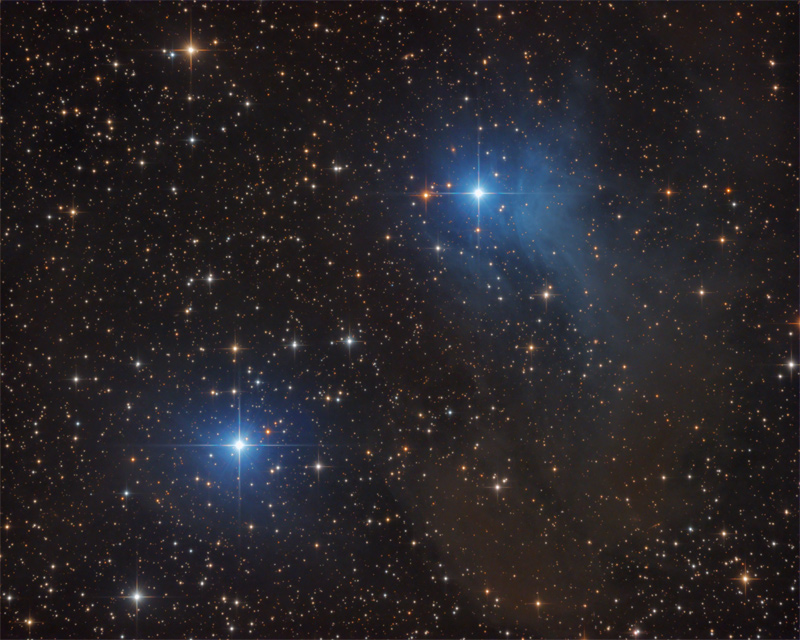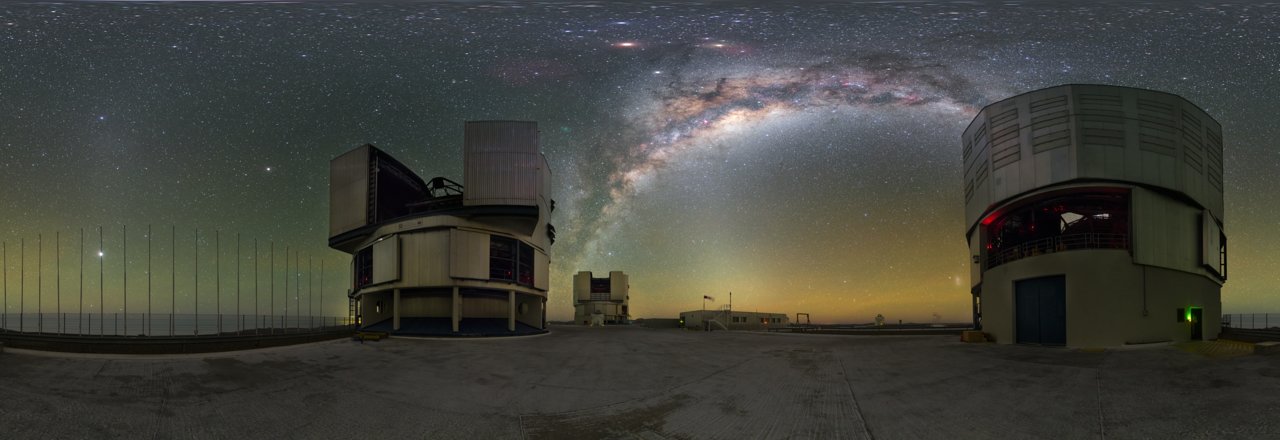Page 1 of 2
Found Images: 2021 February
Posted: Mon Feb 01, 2021 4:03 pm
by bystander
Have you seen a great image or video somewhere that you think would make a great APOD? Nominate it for APOD! Please post as much information here as you have about the image/video with a link to any source(s) for it you know of here, and the editors will take a look.
When posting the image itself, please do not post anything larger than a thumbnail here; please honor the copyright holder's copyright.
Please keep hotlinked images under 500K.
Thank you!
<< Previously
ESO: Astrophotographers Assemble (Paranal)
Posted: Mon Feb 01, 2021 4:27 pm
by bystander
Astrophotographers Assemble
ESO Picture of the Week | 2021 Feb 01
Image Credit: ESO/Petr Horálek
This beautiful photograph of the southern sky was taken by
ESO Photo Ambassador Petr Horálek from ESO’s
Paranal Observatory in Chile. Petr was not alone at Paranal. Standing to the bottom left of the image, next to an
Auxiliary Telescope of the Very Large Telescope Interferometer (
VLTI), are astrophotographers
Yuri Beletsky and
Babak Tafreshi, both of whom are also Photo Ambassadors for ESO. The duo are seen beneath a sky filled with stunning phenomena.
The bright, dominant band of the Milky Way cuts across the sky, with the
Gum Nebula (Gum 12) appearing at the top of the frame in red. The
Large Magellanic Cloud, a satellite galaxy of the Milky Way, is an especially bright blotch to the centre right — just below
Canopus, the brightest star in both this view and the southern constellation of
Carina. A beautiful green and reddish shimmer is also visible at the bottom of the image, seemingly rising up from the horizon. This phenomenon is known as
airglow and consists of faint light emitted by the Earth's atmosphere. Airglow prevents the night sky from being completely dark, and is explained in detail in
ESOcast 78.
ESA: The Modest Galaxy (UGC 3885)
Posted: Mon Feb 01, 2021 4:38 pm
by bystander
The Modest Galaxy
ESA Hubble Picture of the Week | 2021 Feb 01
A bright foreground star isn’t enough to distract from the grandeur of the galaxy
UGC 3885, captured here by the NASA/ESA Hubble Space Telescope. While this foreground star is incredibly bright to Hubble’s eye, it does not outshine the details of the background galaxy.
Many young blue stars are sprinkled throughout the circular patterns of UGC 3885’s arms, contrasted and complemented by dark lanes of dust also following the
spiral structure. A glancing look at UGC 3885 may only leave you with an impression of the galaxy, but spare a moment longer and the intricacies of the galaxy begin to emerge. Located in the constellation of
Lynx, UGC 3885 is a cosmic beauty to behold.
Re: ESA: The Modest Galaxy (UGC 3885)
Posted: Mon Feb 01, 2021 6:34 pm
by Ann
bystander wrote: ↑Mon Feb 01, 2021 4:38 pm
The Modest Galaxy
ESA Hubble Picture of the Week | 2021 Feb 01
A bright foreground star isn’t enough to distract from the grandeur of the galaxy
UGC 3885, captured here by the NASA/ESA Hubble Space Telescope. While this foreground star is incredibly bright to Hubble’s eye, it does not outshine the details of the background galaxy.
Many young blue stars are sprinkled throughout the circular patterns of UGC 3885’s arms, contrasted and complemented by dark lanes of dust also following the
spiral structure. A glancing look at UGC 3885 may only leave you with an impression of the galaxy, but spare a moment longer and the intricacies of the galaxy begin to emerge. Located in the constellation of
Lynx, UGC 3885 is a cosmic beauty to behold.
Can't resist pointing out that the picture of UGC 3885 is a two-filter Hubble image. I have found no information on what actual filters were used, but whatever they were, the two "filter images" were mapped as orange and cyan.
https://apod.nasa.gov/apod/ap210131.html
Ann
Re: Found Images: 2021 February
Posted: Mon Feb 01, 2021 8:13 pm
by thomasroell
The Tadpoles Nebula, IC 410
RGB 22 x 600 sec ISO 3200
Total exposure time 3 hours and 40 minutes
🖥 Edited in AstroPixel Processor, Starnet++, Photoshop and Lightroom
.

Sky-watcher HEQ5, TS-Optics 115/800 Triplet APO, Svbony 60 mm guidescope with a ZWO ASI120MM guidecamera.
🕹ZWO ASIAIR

Canon EOS 750Da, Optolong L-Extreme filter
Re: Found Images: 2021 February
Posted: Mon Feb 01, 2021 10:29 pm
by starsurfer
Re: Found Images: 2021 February
Posted: Mon Feb 01, 2021 10:32 pm
by starsurfer
Re: Found Images: 2021 February
Posted: Mon Feb 01, 2021 10:36 pm
by starsurfer
Re: Found Images: 2021 February
Posted: Mon Feb 01, 2021 10:39 pm
by starsurfer
Kronberger 61
https://www.astrobin.com/9eviog/
Copyright: Boris Chausov
Re: Found Images: 2021 February
Posted: Mon Feb 01, 2021 10:44 pm
by starsurfer
Puppis A
https://www.hansonastronomy.com/pupis-a
Data: Martin Pugh
Processing: Mark Hanson
Re: Found Images: 2021 February
Posted: Sat Feb 06, 2021 11:24 am
by starsurfer
Re: Found Images: 2021 February
Posted: Sun Feb 07, 2021 8:23 pm
by starsurfer
NGC 246
http://www.chart32.de/index.php/component/k2/item/388
Copyright: CHART32
Processing: Konstantin Buchhold
ESO: Zooming in on Star Formation (NGC 6902)
Posted: Mon Feb 08, 2021 3:17 pm
by bystander
Zooming in on Star Formation
ESO Picture of the Week | 2021 Feb 08
Discovered in the year 1836 by
John Herschel,
NGC 6902 is a beautiful
spiral galaxy located more than 130 million light-years away in the constellation of
Sagittarius,
the Archer. This image was taken with
MUSE, the Multi Unit Spectroscopic Explorer instrument attached to one of the four 8.2-metre telescopes that make up the
VLT, and shows the galaxy from a unique perspective. A zoom in towards the galaxy’s centre, the image shows a nuclear ring where the orange glow of intense star formation is visible.
Inside this ring lies a faint and small bar of stars. Researchers
found that stars within it are distributed differently depending on their age, with younger stars aligned along the bar and older stars more dispersed. These locations of the young and old stars within the central bar of
NGC 6902 confirm predictions made years earlier from simulations and models. This is the first time these predictions of galactic structure were confirmed with observations thanks to the incredible spatial resolution of the MUSE instrument.
ESA: A Cosmic Hourglass (M1-63)
Posted: Mon Feb 08, 2021 3:29 pm
by bystander
A Cosmic Hourglass
ESA Hubble Picture of the Week | 2021 Feb 08
This week’s NASA/ESA Hubble Space Telescope Picture of the Week features an impressive portrait of
M1-63, a beautifully captured example of a bipolar
planetary nebula located in the constellation of
Scutum (
the Shield). A nebula like this one is formed when the star at its centre sheds huge quantities of material from its outer layers, leaving behind a spectacular cloud of gas and dust.
It is believed that a
binary system of stars at the centre of the
bipolar nebula is capable of creating hourglass or butterfly-like shapes like the one in this image. This is because the material from the shedding star is funnelled towards its poles, with the help of the companion, creating the distinctive double-lobed structure seen in nebulae such as M1-63.
Re: Found Images: 2021 February
Posted: Mon Feb 08, 2021 10:45 pm
by starsurfer
Re: Found Images: 2021 February
Posted: Tue Feb 09, 2021 8:39 am
by Ann
NGC 6902
http://www.azstarman.net/CDK/NGC6902.htm
Copyright: Bernard Miller
I'm posting this partly as a comment on bystander's recent post about the ESO Picture of the Week,
viewtopic.php?p=310667#p310667.
Bystander's post shows the inner ring of NGC 6902, but Bernard Miller's very fine image shows the entire galaxy. Note the bluish inner ring of NGC 6902 in Miller's image. It's interesting to compare Miller's picture with ESO's.
Ann
Re: Found Images: 2021 February
Posted: Tue Feb 09, 2021 10:58 pm
by starsurfer
Orion Nebula (M42)
https://www.astrobin.com/398087/B/
Copyright: Alberto Ibañez
Re: Found Images: 2021 February
Posted: Tue Feb 09, 2021 11:01 pm
by starsurfer
M16 and M17
https://www.astrobin.com/395586/C/
Copyright: Toshiya Arai
Re: Found Images: 2021 February
Posted: Tue Feb 09, 2021 11:09 pm
by starsurfer
Re: Found Images: 2021 February
Posted: Tue Feb 09, 2021 11:11 pm
by starsurfer
Re: Found Images: 2021 February
Posted: Sat Feb 13, 2021 11:31 pm
by starsurfer
NGC 1448
https://esahubble.org/images/potw1711a/
Copyright: ESA/Hubble & NASA
I wish this was a mosaic!
Re: Found Images: 2021 February
Posted: Sat Feb 13, 2021 11:36 pm
by starsurfer
Re: Found Images: 2021 February
Posted: Sat Feb 13, 2021 11:39 pm
by starsurfer
ESO: A Green Nomad above Giants (Comet 252P/LINEAR)
Posted: Mon Feb 15, 2021 5:38 pm
by bystander
A Green Nomad above Giants
ESO Picture of the Week | 2021 Feb 15
It may not be as famous as
Halley’s Comet, but
Comet 252P/LINEAR can still put on a show! In late March 2016, the comet made one of the closest approaches to Earth of all comets in history — just over 5.3 million kilometres distant, compared to Halley’s closest approach of 87 million kilometres. The light of Comet 252P/LINEAR is not elongated in a classic
tail, but instead appears as a soft round glow, tinged green due to molecules of diatomic carbon fluorescing in the sunlight. This image from April 2016 captures the distinctly green comet: you can spot it just above the Milky Way, between the galaxy’s starry arch and the Very Large Telescope (
VLT)
Unit Telescope at the centre of the frame.
ESO’s VLT is located at the
Paranal Observatory in Chile, an ideal location for comet-spotting. Paranal is one of the most spectacular observatories in the world, situated in the seemingly infinite
Atacama Desert under the dark skies of the southern hemisphere. Comets are not the only treasure visible in these skies: the Milky Way puts on its nightly spectacle, its rich interstellar clouds bejewelled with stars, the diverse colours of natural
airglow shine near the horizon, and high above sit two planets. In this sweeping panorama, they form a slightly distorted triangle that includes the red supergiant star
Antares, with the intense shine of
Mars to the left and the whitish glow of the gas giant
Saturn beneath.
Comet 252P/LINEAR is not easy to find in this image, but using the
zoomable image you can find it just to the right of the upper right edge of the left most telescope.
ESA: Tantrums of a Baby Star (HH 46, HH 47)
Posted: Mon Feb 15, 2021 6:13 pm
by bystander
Tantrums of a Baby Star
ESA Hubble Picture of the Week | 2021 Feb 15
Herbig-Haro objects are some of the rarer sights in the night sky, taking the form of thin spindly jets of matter floating amongst the surrounding gas and stars. The
two Herbig-Haro objects catalogued as
HH46 and
HH47, seen in this image taken with the NASA/ESA Hubble Space Telescope, were spotted in the constellation of
Vela (
The Sails), at a distance of over 1400 light-years from Earth. Prior to its discovery in 1977 by the American astronomer R. D. Schwartz, the exact mechanism by which these multi-coloured objects formed was unknown.
Before 1997 it was theorised by Schwartz and others that the objects could be a type of
reflection nebula, or a type of shock wave formed from the gas emitted from a star interacting with the surrounding matter. The mystery was finally solved when a
protostar, unseen in this image, was discovered at the centre of the long jets of matter. The outflows of matter, some 10 light-years across, were ejected from the newly born star and violently propelled outwards at speeds of over 150 kilometres per second. Upon reaching the surrounding gas, the collision created the bright shock waves seen here.







